Based near Laurencetown in Co Galway, Lisbeg Farms is run by the Bourns family, namely Richard, Deirdre, Chris and Sarah. The family run a mixed farming enterprise consisting of sheep, beef and tillage. Beet has always been a popular crop on the farm, with over 150 acres sown this season and plans to sow up to 200 acres per year.
Over the years the Bourns family always grew a small amount of beet. This was used for both feeding livestock on the farm and for the sugar beet industry. However, it wasn’t until 2007 when Chris decided to focus on growing more of the crop. He started off by purchasing a six-row Armer Salmon drill and initially planted 27 acres. The following year he upped the acreage to 37 acres and purchased a single-row Armer Salmon harvester. Each year from then on Chris planted anywhere from 30 to 60 acres along with carrying out some hire work.
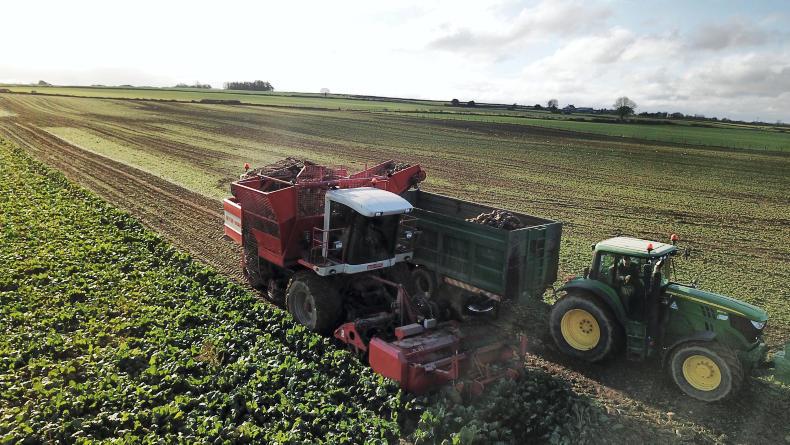
In 2013, he opted to purchase a twin-row Armer Salmon trailed harvester that had been modified to include electric controls and a larger bin. At this stage, Chris was harvesting 110 acres of beet per year. In December 2016, the Armer Salmon harvester was finding it very difficult to lift beet that had been damaged from frost. As a result, Chris purchased a twin-row Thyregod trailed harvester. By now he was harvesting around 120 acres per year for himself.
Earlier this year another farmer came to look at Chris’s beet washing system and ended up buying his Thyregod harvester. At this stage Chris had decided he was going to invest in a self-propelled harvester. To complement the new harvester, Chris purchased a 12-row Stanhay Webb planter from the UK.
Agrifac VKM 9000
Chris decided to purchase the self-propelled harvester for a number of reasons. Firstly, in order to reduce the labour hours required to harvest the crop each year. As there is a lot going on around the farm between the different enterprises, time is of the essence. With the new harvester he has doubled the output in comparison with the previous machine. By increasing his output and freeing up land quicker, this has also allowed Chris to sow a lot more winter wheat in the same ground this autumn.
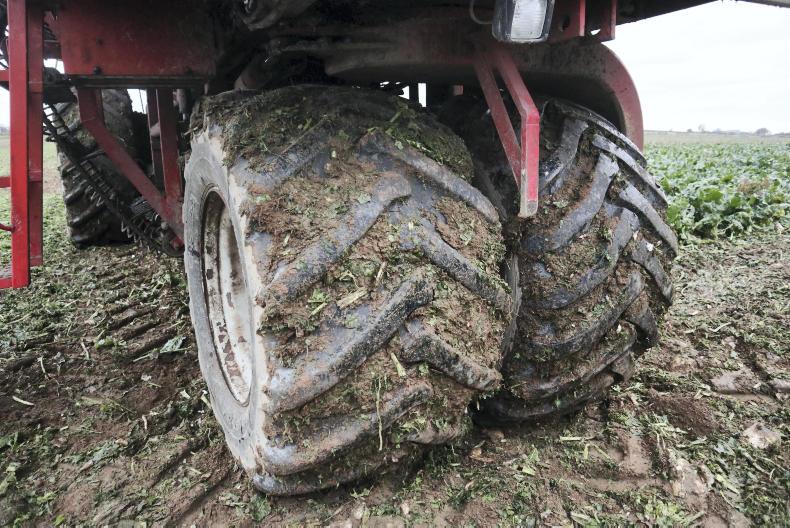
The harvester is running on large flotation tyres, two 710/75R34 on the front and two 700/50x26.5 on the back.
Secondly, compaction was a pressing issue with the previous trailed harvesters. The self-propelled harvester has a larger footprint, spreading the weight of the entire machine across three metres. Each tyre is offset, meaning they all run on different tracks. The harvester is running on large flotation tyres – two 710/75R34s on the front and two 700/50x26.5s on the back. In addition, because he is harvesting six rows instead of one to two rows with the previous harvesters, it means there is less driving up and down the field.
After spending some time searching online, Chris got in contact with Agrifac in the UK. He travelled across the water earlier this year and purchased a 2007 Agrifac VKM 9000 at a cost of €75,000 plus VAT. This price included a one-year warranty.
The workings of the machine
At the front of the machine a flail topper chops the leaves off the beet. Two support wheels determine the cutting height of the flails. An auger and spreader distribute these chopped leaves to the left-hand side of the machine.
Next up are the scalpers. The scalpers cut the heads off the beet. However, these are only used when harvesting sugar beet. Behind the scalpers are the two depth control skids. These skids determine the depth of the walking shares that dig the beet out of the ground. The entire front harvesting unit is in the middle the machine. However, it can be hydraulically shifted to 20cm to the right of the harvester if necessary.

The two support wheels determine the cutting height of the flails.
After digging the beet out of the ground, it is collected using the two large lifting turbines powered by slow-running hydraulic motors. The lifting turbines pass the beet on through the four cleaning turbines. The beet is then transferred into the ring trace elevator which rotates clockwise, dropping the beet into the hopper.
The machine has a 10t hopper, capable of unloading via a conveyer while on the go. Chris explained that the harvester will almost fill a 15t trailer while on the move as it’s both harvesting and unloading at the same time.
Transmission and engine
The harvester is hydrostatically driven. It has both a field mode and a road mode. In field mode, the machine will travel from 0-10 km/h while in road mode it will travel from 0-25 km/h. The harvester is powered by a V6 Deutz engine that churns out 303hp.
It is steered from the rear. However, when using the guidance steer system, the front wheels can steer up to 7° either side. This is to help manoeuvre the machine or to correct the machine if working on a slope.
At the time this machine was built, Agrifac was using Claas cabs. This cab is the same as that of the Claas Jaguar self-propelled foragers of the same era. The only exception is the control layout inside.
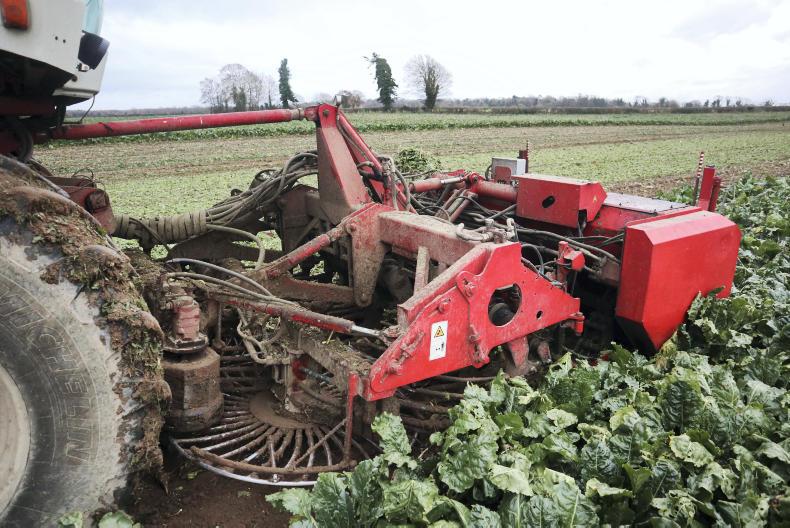
The machine can harvest an average of two acres/hour (at 30t/acre).
Washing
Chris uses an engine-mounted Cross Rhino to de-stone, wash and chop his beet. The unit was purchased new during the summer of 2017. The machine is capable of washing and chopping up to 60t per hour. The Rhino uses a water-powered cyclone washing and cleaning system in combination with a tumbler cleaning cylinder to clean the beet before chopping it.
This year, Chris will be putting 150 acres (estimated over 4,500t of beet) through this machine. Of this beet, Chris will be selling 1,200t, with the remainder being used on farm for finishing 2,000 bulls. Currently he is feeding 10t of beet per day. Beet harvested over the past four to six weeks was yielding 25t/acre while beet harvested this week on Chris’s farm is yielding 30t/acre.
Engine: Deutz V6 diesel engine with ?direct injection and inlet air cooling (intercooler).
Horsepower: 303hp (223kw).
Working width: three metres (six rows).
Transmission: Continuous four-wheel-drive hydrostatic.
Fuel tank capacity: 610 litres.
Output: two acres/hour (at 30t/acre).
Year of manufacture: 2007.
Price paid: €75,000 plus VAT with a one-year warranty.
Based near Laurencetown in Co Galway, Lisbeg Farms is run by the Bourns family, namely Richard, Deirdre, Chris and Sarah. The family run a mixed farming enterprise consisting of sheep, beef and tillage. Beet has always been a popular crop on the farm, with over 150 acres sown this season and plans to sow up to 200 acres per year.
Over the years the Bourns family always grew a small amount of beet. This was used for both feeding livestock on the farm and for the sugar beet industry. However, it wasn’t until 2007 when Chris decided to focus on growing more of the crop. He started off by purchasing a six-row Armer Salmon drill and initially planted 27 acres. The following year he upped the acreage to 37 acres and purchased a single-row Armer Salmon harvester. Each year from then on Chris planted anywhere from 30 to 60 acres along with carrying out some hire work.

In 2013, he opted to purchase a twin-row Armer Salmon trailed harvester that had been modified to include electric controls and a larger bin. At this stage, Chris was harvesting 110 acres of beet per year. In December 2016, the Armer Salmon harvester was finding it very difficult to lift beet that had been damaged from frost. As a result, Chris purchased a twin-row Thyregod trailed harvester. By now he was harvesting around 120 acres per year for himself.
Earlier this year another farmer came to look at Chris’s beet washing system and ended up buying his Thyregod harvester. At this stage Chris had decided he was going to invest in a self-propelled harvester. To complement the new harvester, Chris purchased a 12-row Stanhay Webb planter from the UK.
Agrifac VKM 9000
Chris decided to purchase the self-propelled harvester for a number of reasons. Firstly, in order to reduce the labour hours required to harvest the crop each year. As there is a lot going on around the farm between the different enterprises, time is of the essence. With the new harvester he has doubled the output in comparison with the previous machine. By increasing his output and freeing up land quicker, this has also allowed Chris to sow a lot more winter wheat in the same ground this autumn.

The harvester is running on large flotation tyres, two 710/75R34 on the front and two 700/50x26.5 on the back.
Secondly, compaction was a pressing issue with the previous trailed harvesters. The self-propelled harvester has a larger footprint, spreading the weight of the entire machine across three metres. Each tyre is offset, meaning they all run on different tracks. The harvester is running on large flotation tyres – two 710/75R34s on the front and two 700/50x26.5s on the back. In addition, because he is harvesting six rows instead of one to two rows with the previous harvesters, it means there is less driving up and down the field.
After spending some time searching online, Chris got in contact with Agrifac in the UK. He travelled across the water earlier this year and purchased a 2007 Agrifac VKM 9000 at a cost of €75,000 plus VAT. This price included a one-year warranty.
The workings of the machine
At the front of the machine a flail topper chops the leaves off the beet. Two support wheels determine the cutting height of the flails. An auger and spreader distribute these chopped leaves to the left-hand side of the machine.
Next up are the scalpers. The scalpers cut the heads off the beet. However, these are only used when harvesting sugar beet. Behind the scalpers are the two depth control skids. These skids determine the depth of the walking shares that dig the beet out of the ground. The entire front harvesting unit is in the middle the machine. However, it can be hydraulically shifted to 20cm to the right of the harvester if necessary.

The two support wheels determine the cutting height of the flails.
After digging the beet out of the ground, it is collected using the two large lifting turbines powered by slow-running hydraulic motors. The lifting turbines pass the beet on through the four cleaning turbines. The beet is then transferred into the ring trace elevator which rotates clockwise, dropping the beet into the hopper.
The machine has a 10t hopper, capable of unloading via a conveyer while on the go. Chris explained that the harvester will almost fill a 15t trailer while on the move as it’s both harvesting and unloading at the same time.
Transmission and engine
The harvester is hydrostatically driven. It has both a field mode and a road mode. In field mode, the machine will travel from 0-10 km/h while in road mode it will travel from 0-25 km/h. The harvester is powered by a V6 Deutz engine that churns out 303hp.
It is steered from the rear. However, when using the guidance steer system, the front wheels can steer up to 7° either side. This is to help manoeuvre the machine or to correct the machine if working on a slope.
At the time this machine was built, Agrifac was using Claas cabs. This cab is the same as that of the Claas Jaguar self-propelled foragers of the same era. The only exception is the control layout inside.

The machine can harvest an average of two acres/hour (at 30t/acre).
Washing
Chris uses an engine-mounted Cross Rhino to de-stone, wash and chop his beet. The unit was purchased new during the summer of 2017. The machine is capable of washing and chopping up to 60t per hour. The Rhino uses a water-powered cyclone washing and cleaning system in combination with a tumbler cleaning cylinder to clean the beet before chopping it.
This year, Chris will be putting 150 acres (estimated over 4,500t of beet) through this machine. Of this beet, Chris will be selling 1,200t, with the remainder being used on farm for finishing 2,000 bulls. Currently he is feeding 10t of beet per day. Beet harvested over the past four to six weeks was yielding 25t/acre while beet harvested this week on Chris’s farm is yielding 30t/acre.
Engine: Deutz V6 diesel engine with ?direct injection and inlet air cooling (intercooler).
Horsepower: 303hp (223kw).
Working width: three metres (six rows).
Transmission: Continuous four-wheel-drive hydrostatic.
Fuel tank capacity: 610 litres.
Output: two acres/hour (at 30t/acre).
Year of manufacture: 2007.
Price paid: €75,000 plus VAT with a one-year warranty.











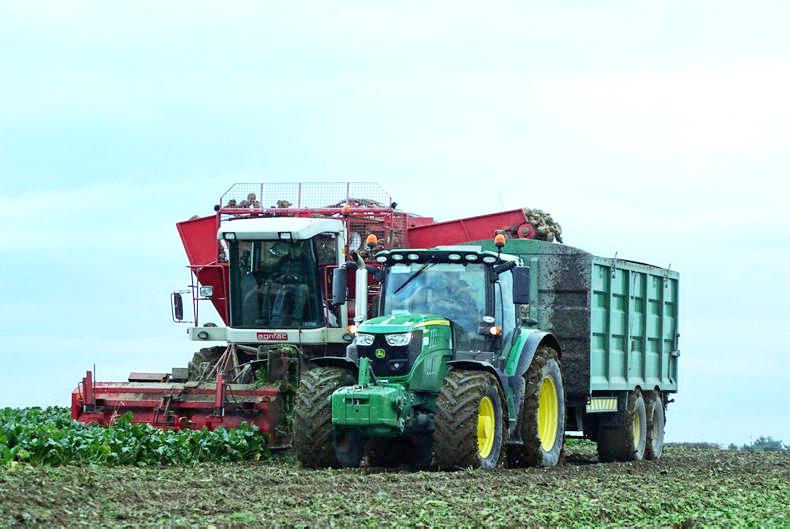
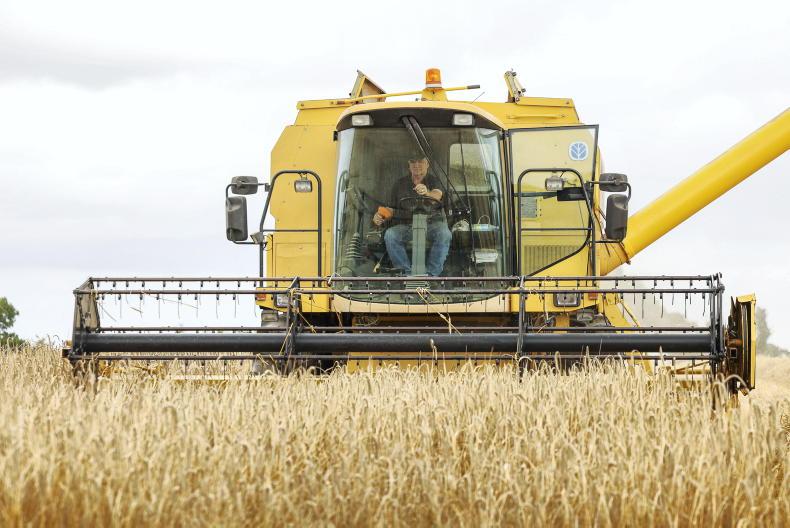

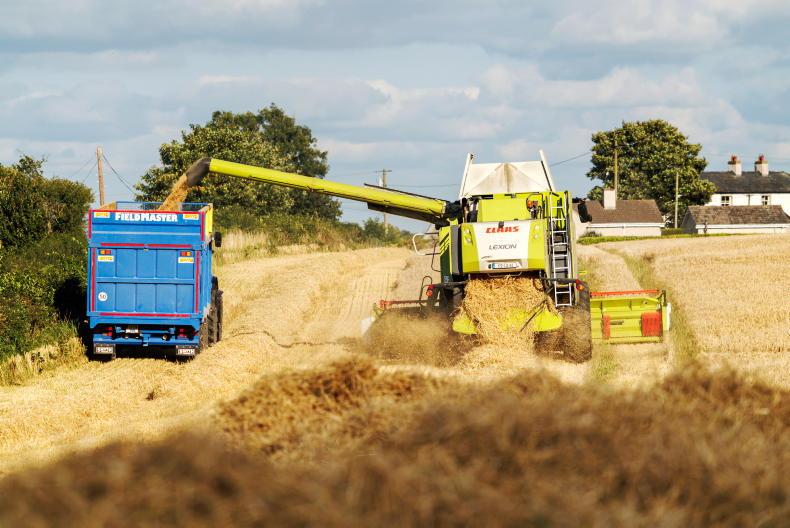
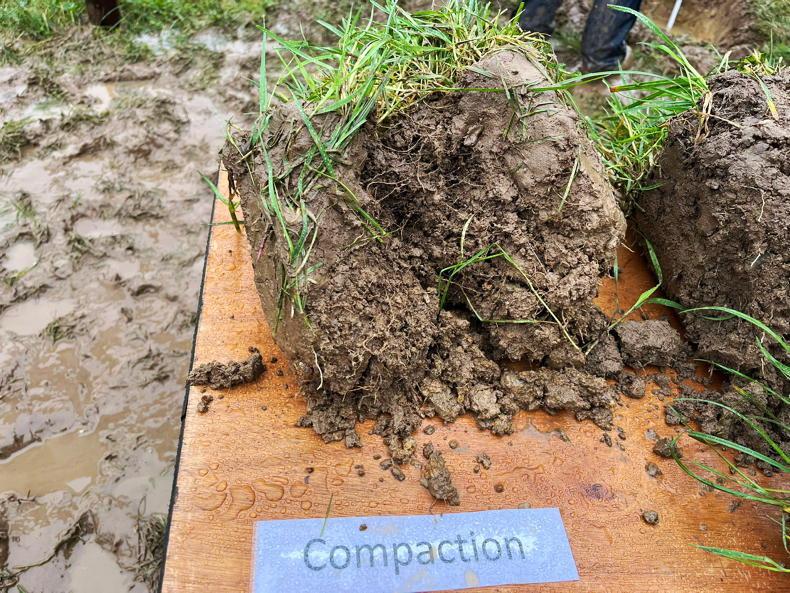
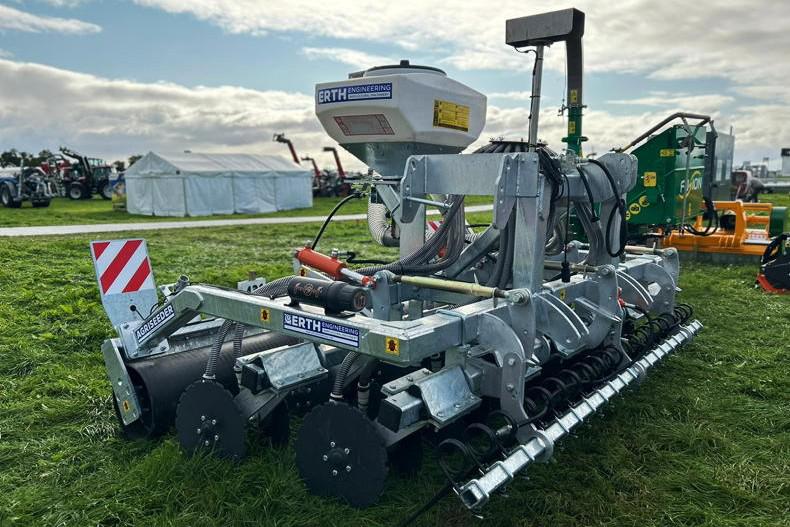
SHARING OPTIONS